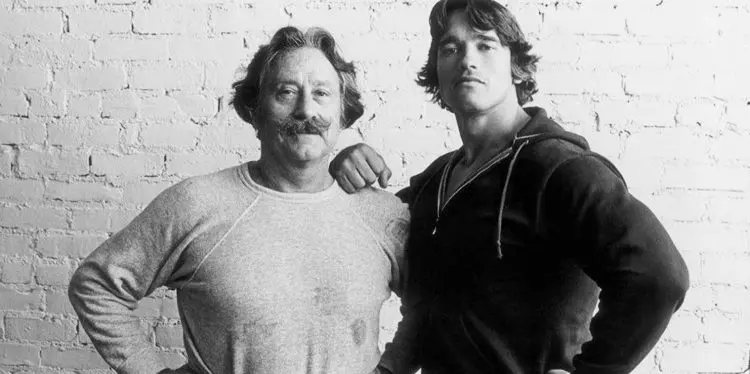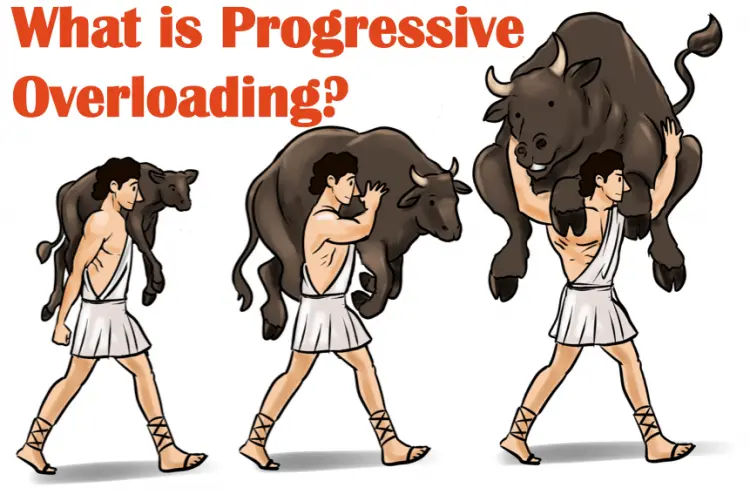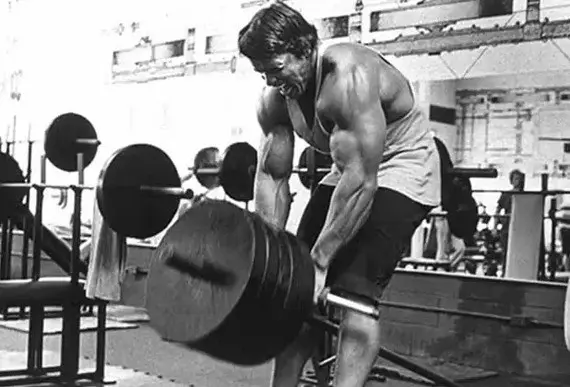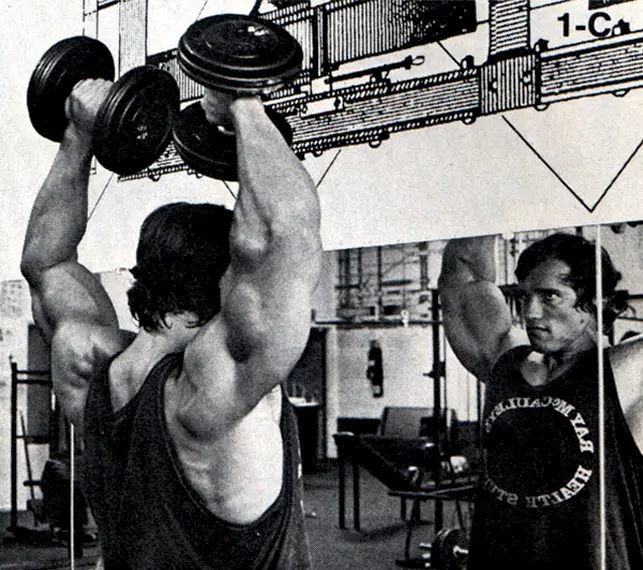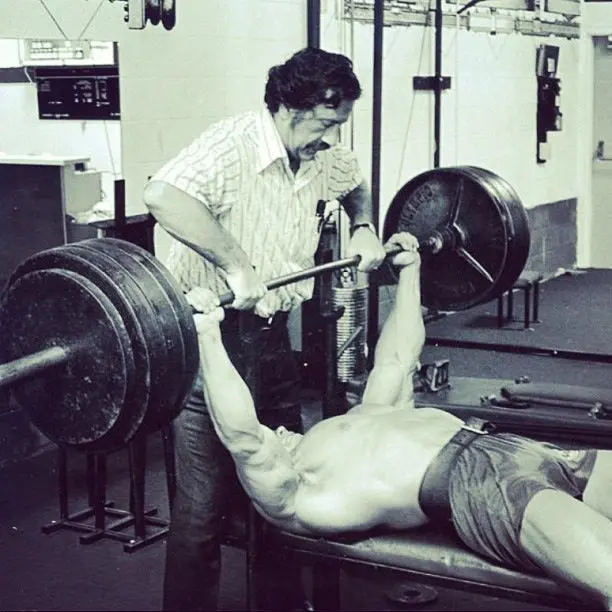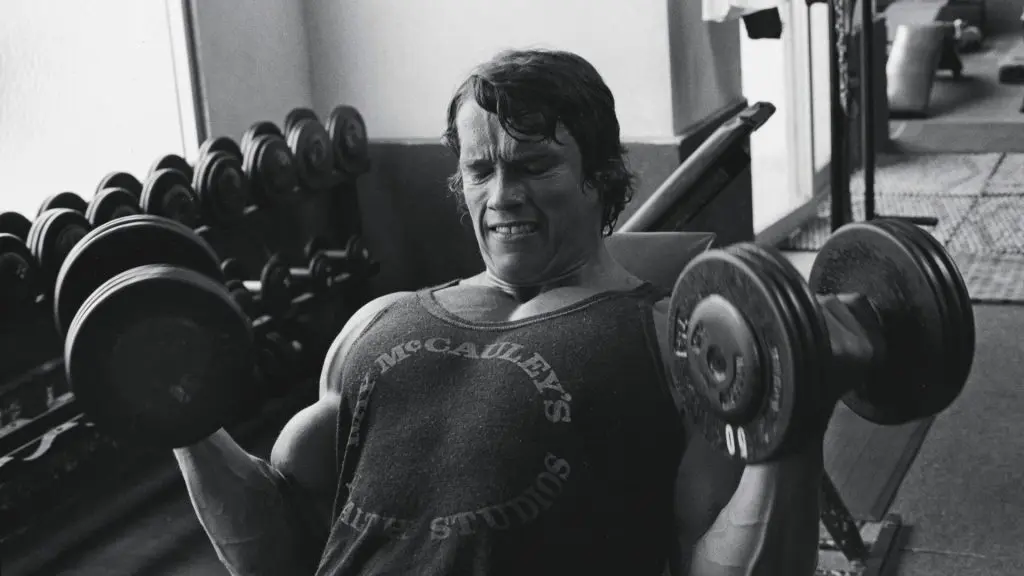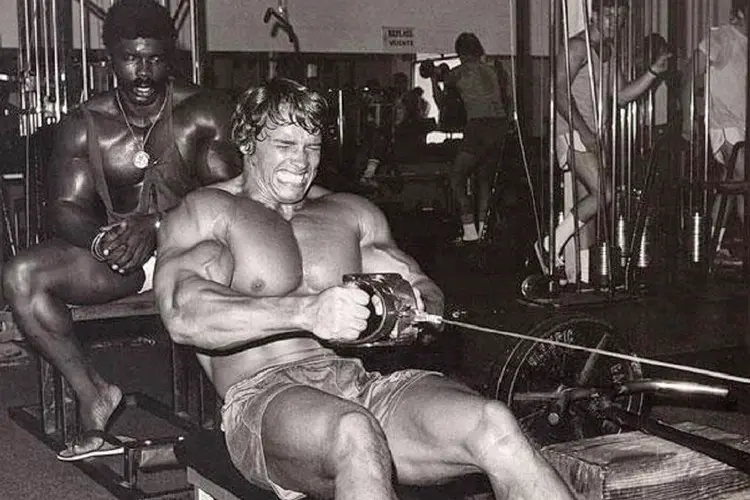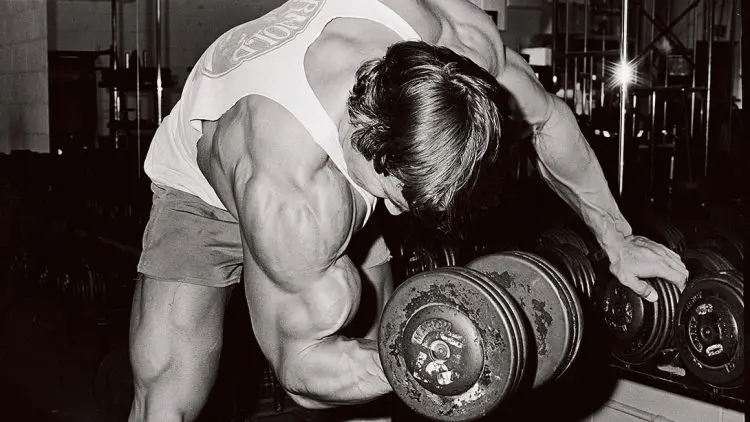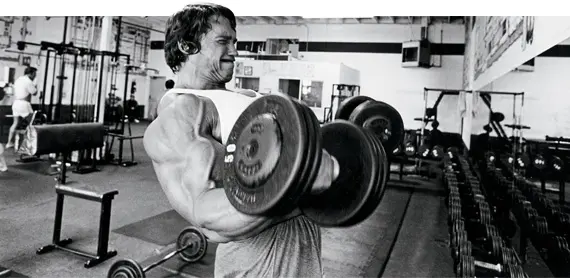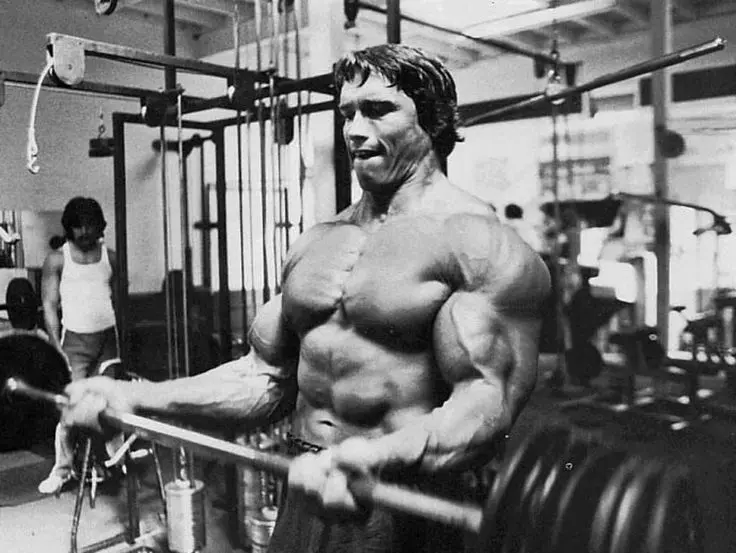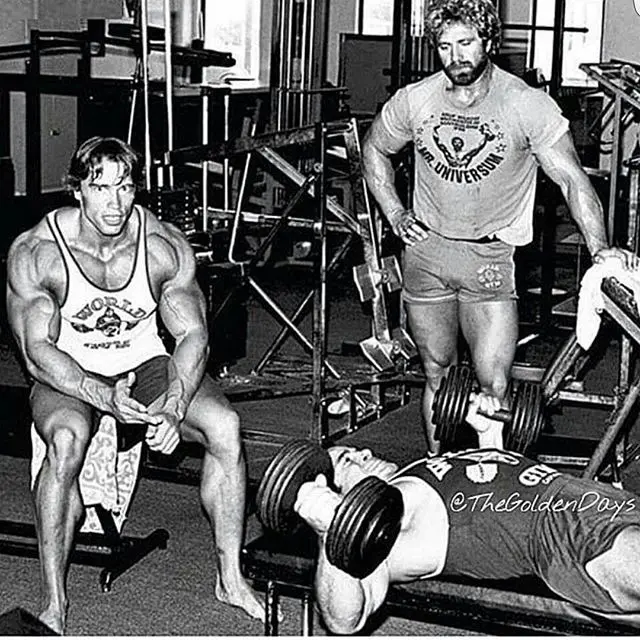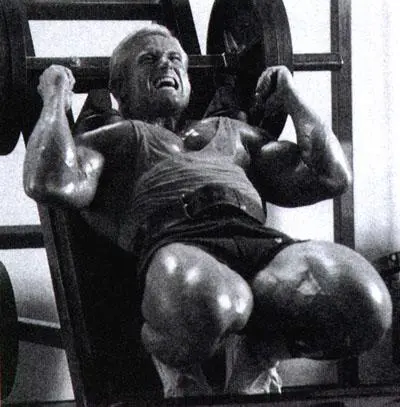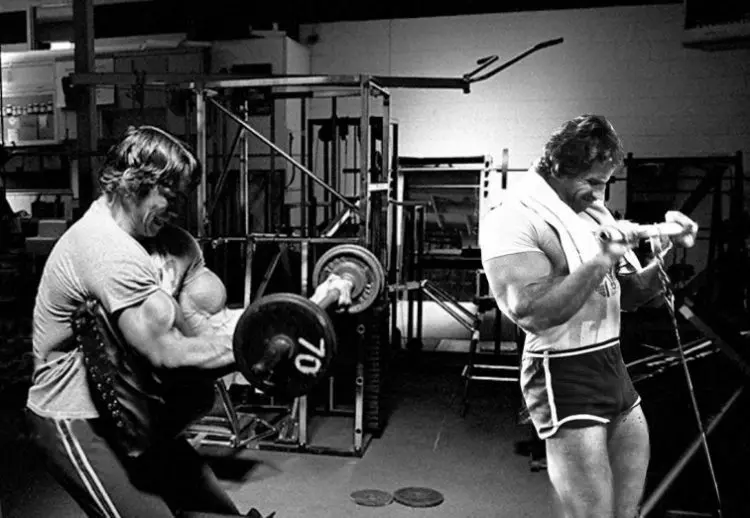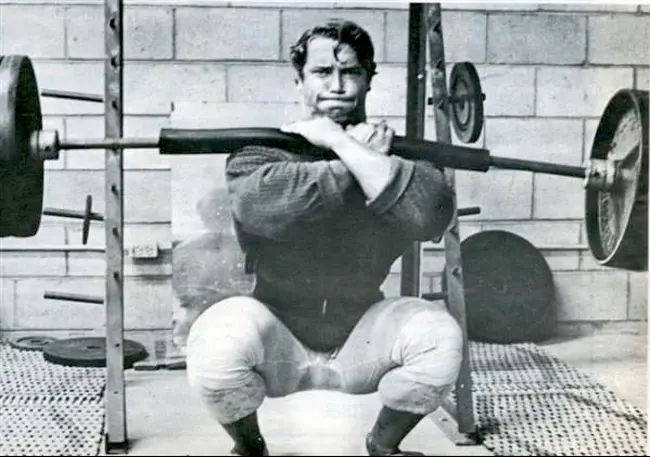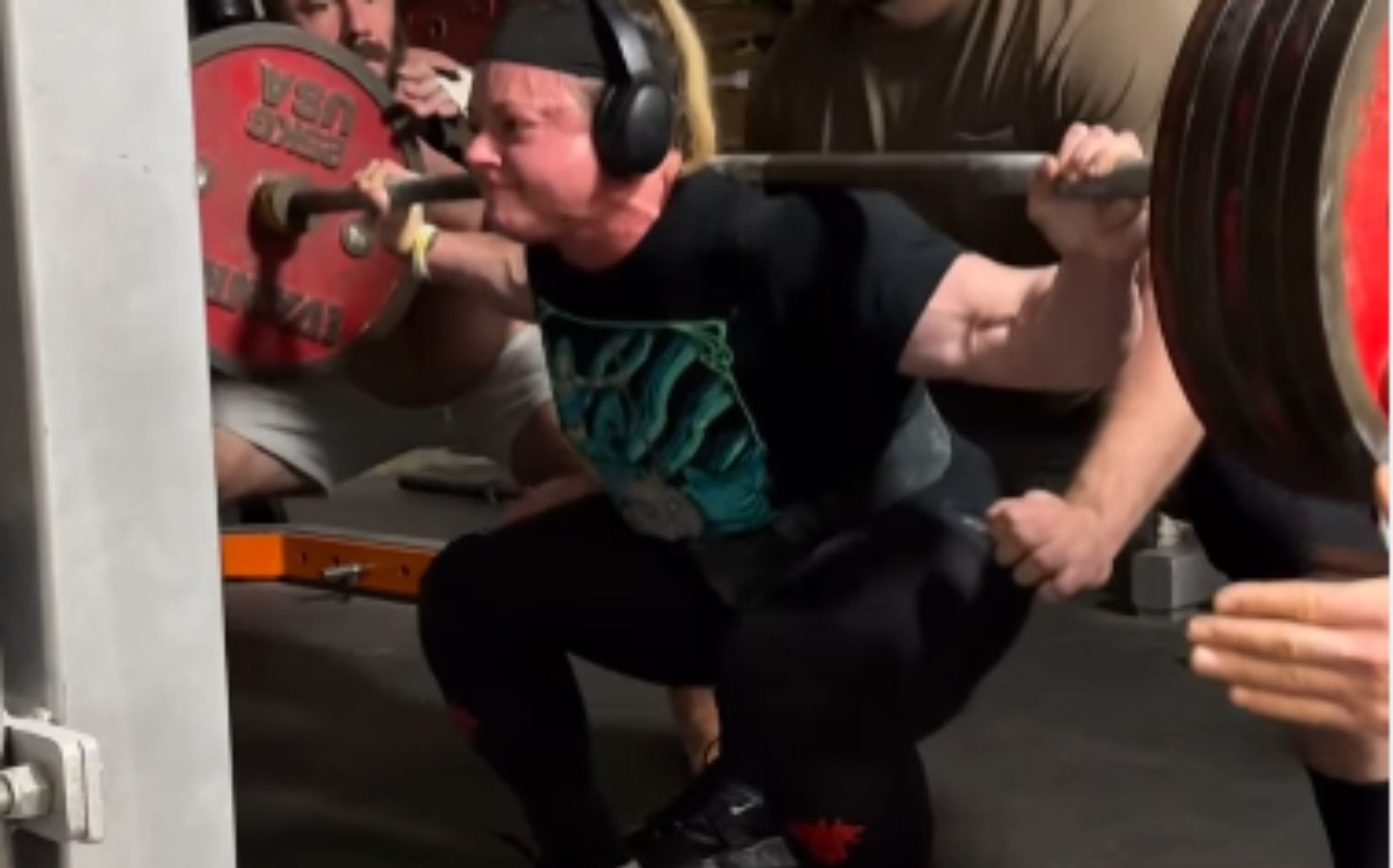Joe Weider is often described as the father of modern bodybuilding. With his brother Ben, he co-founded the International Federation of Bodybuilding and legitimized what was, at the time, considered a very fringe sport.
He brought us the Mr. and Ms. Olympia competitions and founded some of the world’s most influential bodybuilding magazines, including Flex, Muscle & Fitness, and Shape. Weider also produced an extensive range of supplements and training equipment.
Joe Weider died in 2013 at the grand old age of 94. Without Weider, bodybuilding would not be the sport we know and love today. He personally launched the careers of many of the most well-known and loved physique stars.
While Weider himself had a background in Olympic lifting and never really achieved much as a bodybuilder, he was the self-styled “Master Blaster” and claimed he helped train many famous bodybuilders, including Arnold Schwarzenegger.
Ever the self-promoter, Weider created an encyclopedia of training methods he called the Weider Principles, designed to help athletes get more from their workouts. While Weider didn’t actually invent most of these principles, he was the first person to gather them all together to create an all-inclusive guide to training.
Level Up Your Fitness: Join our 💪 strong community in Fitness Volt Newsletter. Get daily inspiration, expert-backed workouts, nutrition tips, the latest in strength sports, and the support you need to reach your goals. Subscribe for free!
In this article, we’re going to review the 25 best Weider Principles and Training methods.
Weider Principle #1: The Progressive Overload Principle
Of all the Weider Principles, this is arguable the most important. The idea of progressive overload is that to grow, your muscles need to be exposed to gradually more demanding workouts. If you do the same workouts using the same weights and same reps, your progress will soon grind to a halt.
Progressive overload can be achieved by doing more reps with the same weight or increasing the weight. However, there are lots of other ways you can make your workouts more demanding. We outlined the ten best methods in this article.
Weider Principle #2: The Multi-Set System Principle
Early bodybuilders typically trained by doing one set of each exercise in their workouts. They did 1-3 exercises per muscle group and usually performed full-body routines. With the multi-set system, Weider suggested that, for maximum size, bodybuilders should do as many as six sets per exercise to fully fatigue the target muscle.
We now know that training volume is as important for hypertrophy as workout intensity, which is why almost all successful bodybuilders use split routines so that they can do multiple sets of several exercises per body part.
Weider Principle #3: The Isolation Principle
Weider believed that to maximize muscular development, bodybuilders should use a combination of compound and isolation exercises. Compound exercises were considered to be mass builders, while isolation exercises were shapers.
While the shape of a muscle is actually determined by genetics, and you cannot truly isolate a single muscle as they typically work in groups, hitting your muscles with isolation exercises makes sense as it allows you to emphasize individual body parts.
Compound exercises are undoubtedly more functional and better for building strength, but if you want to develop maximal muscle size, isolation exercises are very valuable too. They certainly aren’t as pointless as a lot of trainers would have you believe.
Weider Principle #4: The Muscle Confusion Principle
The Muscle Confusion Principle has been used and abused for decades! According to this principle, muscles respond best when they are challenged in new and unusual ways. After all, novel workouts often result in muscle soreness.
Weider never meant that lifters should change their workouts each and every time they trained. Instead, he wanted bodybuilders to avoid getting stuck in a workout rut by making small but regular changes to their training plans to keep their workouts fresh.
Programs like P90X take this principle to extremes, with 12 different push-up variations in a single workout. So much variety is self-defeating. You need some consistency so you can make your workouts progressive. But, small changes like switching from flat to incline bench presses or from barbell to dumbbell biceps curls can help prevent training plateaus.
In simple terms, a little variation can go a long way to making your workouts more productive, but you don’t need to change your workout every time you work out, and you don’t need to do 12 different leg or chest exercises to build muscle.
Weider Principle #5: The Priority Principle
This common-sense principle suggests that you should prioritize your weaknesses by training them first, both at the start of your training session and at the beginning of your training week. This allows you to hit it with plenty of intensity when your focus and energy are at their highest.
Arnold himself used this principle to bring up his weak, small calves. He started each workout with a few sets of calf raises. In a matter of months, the Austrian Oak went from being ashamed of his calves to having some of the best calves in bodybuilding. He also used the staggered sets method, which is covered in point #23.
Weider Principle #6: The Pyramid Training Method
The Weider Pyramid Method should be familiar to most exercisers. After all, it’s how many of us warm-up for heavy weight, low rep training. Weider believed that the pyramid method allowed you to train for muscle size and strength and also ward off injury.
For example:
- 15 reps 20lbs
- 12 reps 30lbs
- 10 reps 40lbs
- 8 reps 50lbs
- 6 reps 60lbs
- 4 reps 70lbs
We know now that overly broad pyramids that include very high and very low reps are not so effective, as it’s hard to adapt to so many different training stimuli at once. However, tighter pyramids that keep you within the rep range for your primary training goal, such as 8-12, can be very useful (1), e.g.:
For example:
- 12 reps 50lbs
- 10 reps 60lbs
- 8 reps 70lbs
Pyramid training can also be done by starting with the heaviest set and lowest weight first; the reverse pyramid method.
Weider Principle #7: The Split Training Method
Pre-1940s old-school bodybuilders mainly used full-body workouts and trained three times per week. This meant they only really had time for one set per exercise. This, Weider believed, was not enough volume for optimal muscle growth.
In order to accommodate his multi-set system, Weider suggested that bodybuilders should train different muscles on different days. He called this the Split Training Method.
Nowadays, split training is the most popular way to arrange your workouts and one that almost every bodybuilder uses, e.g.
For example:
- Monday – chest
- Tuesday – legs
- Wednesday – back
- Thursday – shoulders
- Friday – arms
There are lots of different ways to organize your training week, and we’ve detailed 12 of the best in this article.
Weider Principle #8: The Pump Method
As well as lifting heavy weights, Weider believed that increasing blood circulation was important for muscle growth. This was typically achieved by doing high rep sets with short rests of isolation exercises. Most Weider workouts ended with pump training.
Getting a good pump promotes the delivery of nutrients into the working muscles and may even help stretch the muscle fascia, allowing for more growth. It also plays a part in something called sarcoplasmic hypertrophy, which is the accumulation of fluids in and around the muscle cells, which makes the muscles look bigger.
Learn more about chasing the pump in this article.
Weider Principle #9: The Superset Method
Weider definitely did not invent supersets, but he did popularize them! With supersets, you do two exercises back to back. There are lots of different types of supersets, including:
- Push-pull supersets
- Pre-exhaust supersets
- Post-exhaust supersets
- Upper body-lower body supersets
Supersets can make your workouts more time-efficient, and they can also be used to increase workout intensity and even speed up recovery.
Learn more about this valuable training method in our in-depth guide to supersets.
Weider Principle #10: The Cycle Training Method
Cycle training was what Weider called periodization. With this method, the year is divided into distinct training periods, with each one usually lasting about 8-12 weeks. This could be as simple as alternating between bulking and cutting, or the build-up to and recovery from a big competition.
The idea of cycle training is to achieve a peak, either in performance or appearance, ease off and recover, and then build up to a new, higher peak. Each cycle will be broken up with a deload to avoid plateaus and prevent overtraining.
Weider Principle #11: The Iso-Tension Method
Weider was a big fan of flexing target muscles between sets. For example, you can contract and flex your quads between sets of leg extensions, or your biceps between sets of arm curls.
This, he believed, increased muscle hardness and vascularity. In reality, flexing a muscle between sets will probably increase muscle fiber activation and potentiation, making your next set more productive.
Weider Principle #12: The Peak Contraction Method
With this method, you don’t flex your muscles between sets but midway through a rep. For example, during squats, you contract your thighs as hard as possible before descending into another rep. Or, during biceps curls, you flex your arms at the top of each rep. You can use this method with most exercises and body parts.
This intense training method increases time under tension and reduces blood flow into the muscle, which means it’s a primitive form of blood flow restriction training.
Weider Principle #13: The Mind-Muscle Connection Principle
Weider believed that you really needed to feel the target muscle working for an exercise to be effective. He called this the mind-muscle connection principle. To use this method, you focus your attention on the muscle you are training, ensuring that you can feel it as you move.
A lot of exercisers focus so much on completing their reps that they all but forget about the muscle they’re trying to build. This may make their workouts less effective. For example, during pull-ups or chin-ups, it’s easy to focus so much on pulling your chin up to the bar that you forget all about your lats.
With the Mind-Muscle Connection Principle, you pay extra attention to the target muscle, ensuring you can really feel it working. This may mean using a slower lifting tempo or even using less weight. However, for bodybuilding, it may make your workout more productive.
Weider Principle #14: The Cheating Method
The controversial Weider Cheating Method allows you to extend your set beyond its usual termination point. For example, if you are doing biceps curls, you’ll come to a point where you cannot do any more reps. However, you can use your legs and lower back to help you lift the bar and pump out a couple more reps, essentially cheating the weight up.
Level Up Your Fitness: Join our 💪 strong community in Fitness Volt Newsletter. Get daily inspiration, expert-backed workouts, nutrition tips, the latest in strength sports, and the support you need to reach your goals. Subscribe for free!
This increases your time under tension and the metabolic demand of whichever exercise you are performing, leading to faster progress and better results.
Of course, cheating could also increase your risk of injury, which is why this method is controversial. That said, done sensibly and not too often, it can help make your workouts more productive.
Learn more about the pros and cons of cheating and cheat reps in this guide.
Weider Principle #15: The Instinctive Training Principle
Some lifters are slaves to their bodybuilding workouts. Whatever they’ve got planned, that’s what they’re going to do, right down to those exact poundage, reps, and sets. Unfortunately, energy levels and even motivation can vary from day to day, and you never know how you’re going to feel until you start training.
The Weider Instinctive Training Principle states that you should modify your workouts based on how you feel. If you’re having an off day, it’s perfectly acceptable to cut your workout short or use lighter weights. Similarly, if you are blasting through your training with ease, feel free to increase your weights or do more reps.
This doesn’t mean you can just make up your workouts as you go along but that you can modify them to match your current physical and mental state.
Slogging through a workout that feels much harder than usual can be demotivating and could even cause injury. Conversely, if you’re feeling good, why not make the most of your energy by training a little harder than usual.
The Instinctive Training Principle means listening to your body and acting on the messages it’s sending you.
Weider Principle #16: The Tri-sets and Giant Set Methods
Weider liked to use tri-sets and giant sets to bring up lagging body parts. Where supersets involve doing two exercises back-to-back, tri-sets involve three, and giant sets involve four sets or more.
These methods are very taxing, increase time under tension, and trigger a skin-splitting pump. Usually, all the exercises in a tri-set or giant set are for the same muscle group.
For example:
Chest tri-set
- Bench press
- Dumbbell flys
- Push-ups
Leg giant set
- Squats
- Lunges
- Leg extensions
- Leg curls
- Leg press
Tri-sets and giant sets are also used during fat loss or cutting training as they also have a cardiovascular and metabolic component.
Weider Principle #17: The Rest-Pause Method
The Weider Rest-Pause Method is much loved by both bodybuilders and powerlifters. It allows lifters to do more reps with a heavy weight, which is useful for building strength and size.
Let’s say you can do eight pull-ups. Using rest-pause, you can do 12 or even 15 reps. Simply rep out to failure, take a 10-15 second rest, and then pump out a few more reps. Rest again, and do a couple more. Continue until you hit your rep target.
For example:
- 8 reps
- Rest
- 4 reps
- Rest
- 2 reps
- Rest
- 1 rep
- Rest 90-120 seconds and repeat
Your next set may start with a lower number of reps, but you should still be able to accumulate a similar total simply by doing more rest-pause reps.
Weider Principle #18: The Partial Reps AKA Burns Method
If you like pain and a good pump, this is the Weider training method for you. With this system, you rep out as usual to failure, and then do some short-range reps to fully exhaust your muscles.
For example, after a set of calf raises, on reaching failure, just lift and lower your heels a few inches to get an intense burn. The short range of motion will mean you can pump out quite a few reps before the accumulation of lactic acid forces you to end your set.
The Partial Reps Method works best with isolation exercises. Be warned, it really does live up to its more common name of burns.
Weider Principle #19: The Descending Sets Method
Weider was often guilty of taking an established training method and renaming it to make it sound original. What the Master Blaster called descending sets, most bodybuilders know as drop sets.
With descending sets, you rep out as normal and, on reaching failure, lower the weight by 10-20% and then rep out again. This allows you to train past failure, increase time under tension, and get an even better pump.
Descending sets work best with dumbbells and machines, as, to be effective, you must reduce the weight quickly and get back to training before your muscles recover too much. That said, you could also do descending sets with fixed weight barbells.
Weider Principle #20: The Retro-Gravity Method
This is another Weider training method that most lifters know by another name – negative training. You are stronger eccentrically than you are concentrically, which means you can lower more weight than you can lift.
With the Weider Retro-Gravity Method, you load the bar with more weight than you can lift on your own, have a training partner help you get the bar up, and then lower it yourself to expose your muscles to more overload than usual.
Another way to do this is with single limb exercises. For example, use two legs to lift the weight during leg extensions, but then lower the weight using just one leg.
While the Weider Retro-Gravity Method is effective, it can lead to severe muscle soreness and can take a toll on your nervous system too. It can take several days to fully recover from a retro-gravity workout.
Weider Principle #21: The Continuous Tension Method
With this training method, you lift and lower your weights under control, neither pausing at the top of each rep or at the bottom. In other words, once you start your set, the weight keeps moving until you are unable to continue.
With no mid-rep pauses, you won’t be able to use as much weight with this method, but the constant tension and metabolic damage should produce excellent hypertrophic results. Continuous tension is an excellent way to finish off the muscle group you are training.
For example, on leg day, do your workout as normal and then, for your last exercise, do continuous tension leg presses. Unrack the weight and then lower and lift the footplate without stopping until you cannot continue. Do not lock your knees at the top or stop at the bottom of any rep. Done right, just a couple of sets should be all you need to exhaust your muscles.
Weider Principle #22: The Double Split Method
This Weider training method is ideal for people with home or garage gyms or that have plenty of time to work out. It’s also excellent for younger bodybuilders with exceptional recovery abilities.
With the Double Split Method, you train twice a day, usually working a large muscle group first and a smaller muscle group several hours later.
For example:
- AM: Quads/hamstrings
- PM: Calves
Or:
- AM: Chest
- PM: Triceps
Or:
- AM: Back
- PM: Biceps
Taking a few hours rest between body parts means you can train each one with maximum intensity.
Weider Principle #23: The Staggered Sets Method
If you have a lagging body part, this is one way to fix it. With this method, you do a set for your weaker muscle group while you are resting between sets of your main workout exercises. For example, if your calves are weak, you might do a set of calf raises between each set of your chest and back workout.
This method increases training volume without making your workout any longer. Take care not to choose exercises that would impair your performance of your main workout, so don’t do a set of triceps pushdowns between sets of bench presses or a set of biceps curls between sets of pull-ups.
Weider Principle #24: The Superspeed Method
Superspeed is another training method that a lot of bodybuilders know by a different name. In this case, it’s Compensatory Acceleration Training or CAT for short. With the Superspeed Method, you lower the weight at the usual speed but then try and lift it as fast as possible.
This increases muscle fiber activation and could lead to greater increases in muscle strength and power. Lifting explosively also preferentially targets the fast-twitch (type 2b) muscle fibers, which have the greatest potential for hypertrophy.
This method is useful for anyone who wants to not only look strong and powerful but actually be strong and powerful too. It’s a useful method for athletes, weightlifters, and powerlifters.
Weider Principle #25: The Quality Training Method
The name of this method is quite confusing, but that doesn’t mean it’s not effective. With the Weider Quality Training Method, you gradually reduce the length of your rests between sets to make your workouts more demanding. As the rests get shorter, you’ll be less recovered, and your next set will be more challenging.
For example:
- Week 1 – 90 seconds between sets
- Week 2 – 80 seconds between sets
- Week 3 – 70 seconds between sets
- Week 4 – 60 seconds between sets
- Week 5 – increase the weight and go back to 90 seconds between sets
This could just have easily been called the descending rest method but, Weider, for reasons unknown, called it the Quality Training Method instead.
Wrapping Up
Joe Weider did not invent many of these methods or principles. Most of them were in use long before Weider built his bodybuilding empire. He even adopted and adapted methods from his business rivals, changing their names and claiming them as his own.
However, by gathering the best methods together and publishing them as the Weider Training Principles, the father of modern bodybuilding created one of the most comprehensive guides to bodybuilding training.
Do you need to use all these methods to be a successful bodybuilder? Of course not! But, they’re all valid methods that can add a lot to your workouts.
Weider might not have invented these methods, but he still deserves our thanks for publishing and publicizing them. After all, without his work, things like supersets and split routines would be much less well-known.
References:
1 – PubMed: Effects of Traditional and Pyramidal Resistance Training Systems on Muscular Strength, Muscle Mass, and Hormonal Responses in Older Women: A Randomized Crossover Trial (source)

